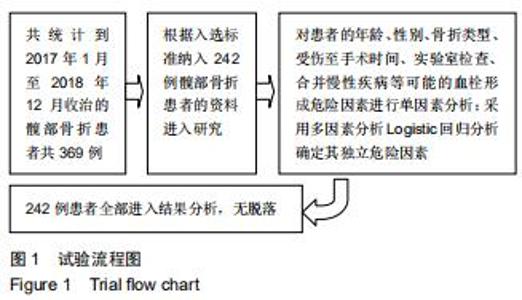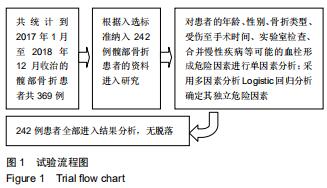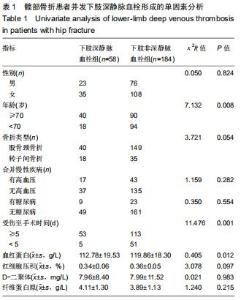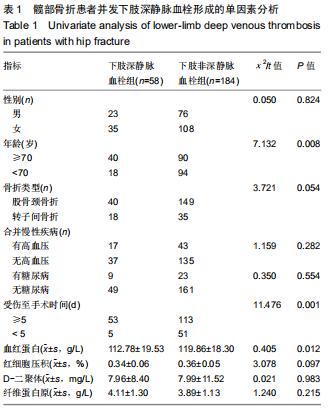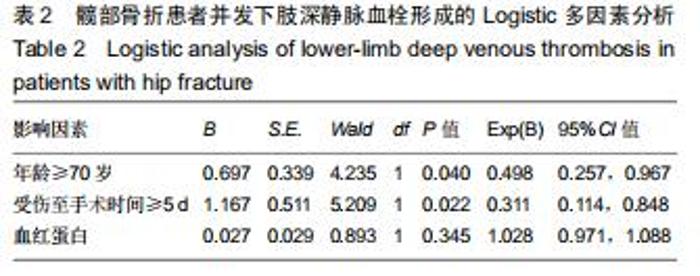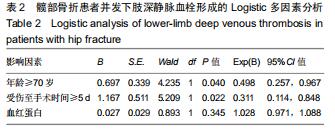|
[1] SHIN WC, LEE SM, SUH KT. Recent updates of the diagnosis and prevention of venous thromboembolism with a hip fracture. Hip Pelvis.2017;29(3):159-167.
[2] LIN YC, LEE SH, CHEN IJ, et al. Symptomatic pulmonary embolism following hip fracture:A nationwide study. Thromb Res.2018;12(172):120-127.
[3] GODZIK J, MCANDREW CM, MORSHED S, et al. Multiple Lower-extremity and pelvic fractures increase pulmonary Embolus risk.Orthopedics.2014;37(6):517-524.
[4] KEARON C1, AKL EA.Duration of anticoagulant therapy for deep vein thrombosis and pulmonary embolism.Blood. 2014;123(12): 1794-1801.
[5] 中华医学会外科学分会血管外科学组.深静脉血栓的诊断和治疗指南[J].中国血管外科杂志(电子版),2013,5(1):23-26.
[6] PAN Y, MEI J, WANG L, et al. Investigation of the incidence of perioperative pulmonary embolism in patients with below-knee deep vein thrombosis after lower extremity fracture and evaluation of retrievable inferior vena cava filter deployment in these patients. Ann Vasc Surg. 2019;10(60):45-51.
[7] ZAHN HR, SKINNER JA, PORTEOUS MJ. The preoperative prevalence of deep vein thrombosis in patients with femoral neck fractures and delayed operation.Injury.1999;30(9):605-607.
[8] HEFLEY FG JR, NELSON CL, PUSKARICH-MAY CL. Effect of delayed admission to the hospital on the preoperative prevalence of deep-vein thrombosis associated with fractures about the hip. J Bone Joint Surg Am.1996;78(4):581-583.
[9] XING F, LI L, LONG Y, et al. Admission prevalence of deep vein thrombosis in elderly Chinese patients with hip fracture and a new predictor based on risk factors for thrombosis screening.BMC Musculoskelet Disord.2018;19(1):444.
[10] 王京,杨明辉,孙旭,等.老年髋部骨折患者术前下肢深静脉血栓形成的危险因素分析[J]. 医学综述,2018,24(23):4581-4585。
[11] SONQ K, YAO Y, RONQ Z, et al. The preoperative incidence of deep vein thrombosis (DVT) and its correlation with postoperative DVT in patients undergoing elective surgery for femoral neck fractures. Arch Orthop Trauma Surg. 2016;136(10):1459-1464.
[12] CHO YH, BYUN YS, JEONG DG, et al. Preoperative Incidence of Deep Vein Thrombosis after Hip Fractures in Korean. Clin Orthop Surg. 2015;7(3):298-302.
[13] 孙健平,薛汉中,王鹏飞,等. 髋部骨折术前双下肢深静脉血栓发生率及其危险因素分析[J].骨科,2018,9(6):464-468.
[14] ZAW HM, OSBORNE IC, PETTIT PN, et al. Risk factors for venous thromboembolism in orthopedic surgery. Isr Med Assoc J. 2002;4(11):1040-1042.
[15] DI MINNO G, TUFANO A. Challenges in the prevention of venous thromboembolism in the elderly. J Thromb Haemost. 2004;2(8): 1292-1298.
[16] WAKABAYASHI H, HASEGAWA M, NIIMI R, et al. Clinical analysis of preoperative deep vein thrombosis risk factors in patients undergoing total hip athroplasty. Thromb Res. 2015; 136(5):855-858.
[17] 孙宁,杨帆,李宇能,等.新鲜下肢骨折术前深静脉血栓形成危险程度评分量表初探[J].中华外科杂志,2015,53(2):101-105.
[18] SHIN WC, LEE SM, SUH KT. Preoperative prevalence of and risk factors for venous thromboembolism in patients with a hip fracture: an indirect multidetector CT venography study. J Bone Joint Surg Am. 2016;98(24):2089-2095.
[19] SMITH EB, PARVIZI J, PURTILL JJ. Delayed surgery for patients with femur and hip fractures-risk of deep venous thrombosis. J Trauma. 2011;70(6):E113-E116.
[20] 范吉星,李宁,龚晓峰,等.老年髋部骨折术前下肢深静脉血栓形成的影响因素研究[J].中国矫形外科杂志,2017,25(22):2027-2031.
[21] LIM YW, CHONG KC, CHONG L, et al. Deep vein thrombosis following hip fracture and prevalence of hyperhomocysteinaemia in the elderly. An Acad Med Singapore. 2004;33(2):235-238.
[22] KWON D, MILLIRON M. D-dimer test for excluding the diagnosis of pulmonary embolism. Ann Emerg Med. 2017;70(3): e31-e32.
[23] UNLU Y, KARAPOLAT S, KARACA Y, et al. Comparison of levels of inflammatory markers and hemostatic factors in the patients with and without peripheral arterial disease. Thromb Res. 2006; 117(4):357-364.
[24] LINDNER G, FUNK GC, PFORTMUELLER CA, et al. D-dimer to rule out pulmonary embolism in renal insufficiency. Am J Med. 2014;127(4):343-347.
[25] 付亚辉,王鹏飞,王宝辉,等.老年髋部骨折患者围手术期深静脉血栓形成的发生规律及血浆D-二聚体的变化特点[J].中华创伤骨科杂志, 2016,18(8):668-672.
[26] 郭兴仁,丁允知,周勇,等.高龄髋部骨折患者手术前发生DVT的影响因素分析[J].现代生物医学进展,2016,16(34):6698-6702.
[27] FULMMER AC, MILLER R. Retrospective review oF hemoglobin and/or hematocrit levels with occurrence of thrombosis in cancer patients treated with erythropoiesis stimulating agents. J Oncol Pharm Pract. 2009;15(3):167-173.
|
